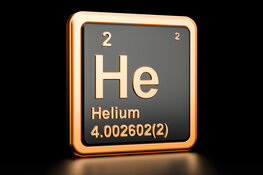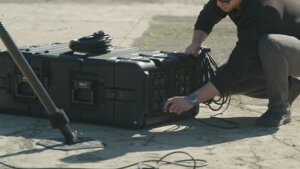Despite the advent of drones and other high-tech weapons, artillery shells and bullets still win wars. And according to a Bloomberg report, the United States is playing catch-up when it comes to producing the shells needed to face growing global instability. General Dynamics Corp. (GD:NYSE)
The standard NATO artillery munition, the 155-millimeter shell, is 2 feet tall and weighs about 100 pounds.
Since the Cold War ended, the U.S. shifted focus from ground-based munitions to high-tech weaponry, making just 14,400 shells a month before Russia's invasion of Ukraine. Now, the U.S. is spending more than US$5 billion to overhaul aging factories, hoping to make 100,000 per month by the end of the year.
One of those is a 15-acre complex in Scranton, Pennsylvania, a historic factory where steam locomotives were once made and about 300 people working for General Dynamics Corp. (GD:NYSE) now forge steel into the cylinders that will be packed with explosives.
"The Army has poured about (US)$429 million into updating Scranton," wrote the authors of the Bloomberg report on June 7, Roxana Tiron and Billy House. "The plant's cramped rooms are being refurbished, and its floors reinforced to bear the weight of new machinery. To further ramp up production, the Army opened a (US)$500 million facility, also run by General Dynamics, in Mesquite, Texas, at the end of May. A new metal parts facility in Canada run by IMT Defence will also make shells."
The Catalyst: Changes in Warfare
Much of the funding for the projects will come from the recently passed U.S. spending bill, which had survived a 6-month political battle led by Republicans opposing further assistance for Ukraine.
But the increased production will also boost the domestic economy while providing for America's own defense, some argue.
"These are American workers producing cutting-edge equipment," Republican U.S. Senate Minority Leader Mitch McConnell told reporters recently. "I have a hard time seeing what's wrong with doing this. It's exactly what we need to do, not only for Ukraine but for ourselves."
The changes in warfare have prompted NATO to increase its stockpiling guidelines for munitions.
"A new age of conflicts being fought with old-standby weapons has exposed the move away from making basic munitions as a strategic error," the Bloomberg authors wrote. "In recent months, US supplies of 155mm shells have been drained by shipments to Ukraine and Washington's support of Israel’s operations in the Gaza Strip . . . Higher-tech shells that were intended to replace the traditional 155mm munitions failed an early test in Ukraine, when their targeting systems were thwarted by Russia."
Stacie Pettyjohn, a senior fellow and director of the defense program at the independent and bipartisan Center for a New American Security, told Bloomberg that it has taken the war in Ukraine to really shock Pentagon officials and members of Congress into action.
"The writing has been on the wall for a while," she said.
But U.S. officials see arming Ukraine as a way to enhance their own readiness for future conflicts, the Bloomberg article reported.
"They are long term-investments, decades-long investments," said Doug Bush, the U.S. Army's top weapons buyer.
General Dynamics Corp.
On its website, General Dynamics notes that its portfolio of businesses "spans the realm of the world's most technologically advanced business jets, wheeled combat vehicles, command and control systems, and nuclear submarines."
The company said it has four business groups: aerospace, marine systems, combat systems, and technologies. For munitions, the company said it produces "all calibers of munitions for the U.S. government and its allies."
The company released its quarterly earnings on April 24, reporting US$2.88 earnings per share for the quarter, missing analysts' consensus estimates of US$2.89, according to Defense World. It had revenue of US$10.73 billion for the quarter, compared to analyst estimates of US$10.26 billion. General Dynamics had a net margin of 7.85% and a return on equity of 16.48%.
The company's revenue for the quarter was up 8.6% compared to the same quarter last year when it posted earnings of US$2.64 per share. The firm also recently disclosed a quarterly dividend of US$1.42 per share that will be paid in August.
According to the Defense World article, the Royal Bank of Canada has rated the stock "Outperform" with a target price of US$320 per share. It also quoted MarketBeat.com as saying General Dynamics has a consensus rating of "Moderate Buy" with an average target price of US$300.63.
A report sent by Stock Traders Daily on June 11, 2024, gave General Dynamics Corp. a Neutral rating in the near and midterm and a Strong rating in the long term.
A Leading Industry Player
According to research by Markets and Markets, the global ammunition market is expected to grow from US$28 billion in 2023 to US$33.1 billion in 2028, with a compound annual growth rate (CAGR) of 3.4%.
"Terrorism, regional conflicts, and geopolitical disputes have become global issues, posing potential risks to countries and their populations," the firm's analysts wrote. "Governments of different countries are procuring and maintaining an inventory of advanced warfare equipment and ammunition to maintain peace. Ammunition forms an integral component of combat equipment and arms that are owned by various military and law enforcement agencies across the globe."
The report named General Dynamics among the "leading industry players" in the U.S., along with Northrop Grumman Corp.
A study by Credence Research predicted a CAGR of 5.45% between 2023 and 2032 to a market of US$107.45 billion for the munitions sector.
"Governments often escalate military spending to adequately equip and train their forces in response to perceived threat or ongoing conflicts," researchers wrote. "This surge in procurement activities for weapons and ammunition is a direct outcome of the need to maintain national security and prepare for potential engagements, making this sector highly sensitive to geopolitical events."
Ownership and Share Structure
According to Reuters, management and insiders own about 0.6% of General Dynamics, and institutions own 86.4%.
Top shareholders include Longview Asset Management LLC with 10.24%, The Vanguard Group Inc. with 7.92%, Newport Trust Co. with 5.7%, Wellington Management Co. with 5.26%, BlackRock Institutional Trust Co. with 4.09%, State Street Global Advisors (US) with 3.59%, MFS Investment Management with 2.62%, Wells Fargo Advisors with 2.28%, Capital Research Global Investors with 2%, and Geode Capital Management LLC with 1.73%.
It has a market cap of US$80.13 billion with 274.36 outstanding shares and 272.71 free float traded shares. It trades in a 52-week range of US$302.42 and US$209.25.
| Want to be the first to know about interesting Special Situations investment ideas? Sign up to receive the FREE Streetwise Reports' newsletter. | Subscribe |
Important Disclosures:
- Steve Sobek wrote this article for Streetwise Reports LLC and provides services to Streetwise Reports as an employee.
- This article does not constitute investment advice and is not a solicitation for any investment. Streetwise Reports does not render general or specific investment advice and the information on Streetwise Reports should not be considered a recommendation to buy or sell any security. Each reader is encouraged to consult with his or her personal financial adviser and perform their own comprehensive investment research. By opening this page, each reader accepts and agrees to Streetwise Reports' terms of use and full legal disclaimer. Streetwise Reports does not endorse or recommend the business, products, services or securities of any company.
For additional disclosures, please click here.




































